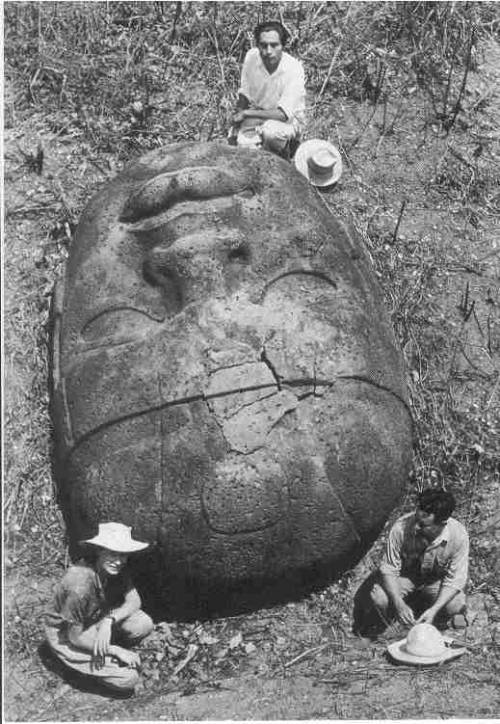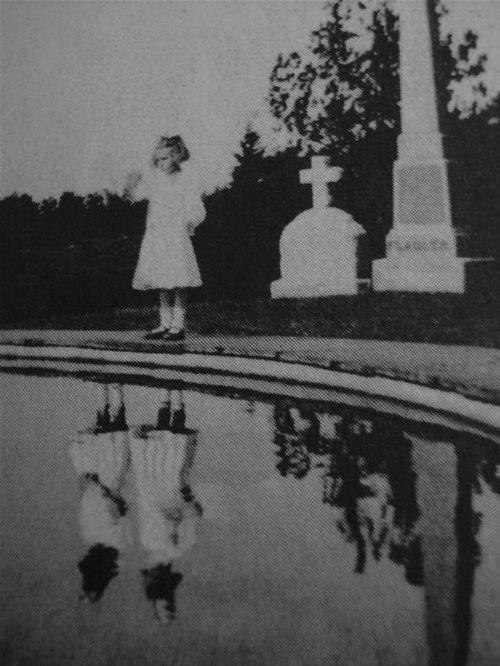The archaeologist Matthew Stirling and his wife, Marion Illig, posing with a recently discovered and restored Olmec head in San Lorenzo Tenochtitlán (Veracruz, Mexico, 1945). The Olmec civilization existed before the Incas
Robert Wadlow was the tallest person in history. He reached 8 ft 11.1 in (2.720 m) in height and weighed 439 lb (199 kg) at his death at age 22 in 1940.
Invisible twin
Photo taken in early 1900's

Showmen’s Rest: Chicago’s Clown Graveyard

An elephant statue marks Showmen’s Rest, a mass grave of clowns and other circus performers. The lowered trunk symbolizes mourning.
In Forest Park, Illinois, the Woodlawn Cemetery contains a large plot marked by elephant statues. Engraved at the base of one large elephant are the words Showmen’s League of America. On the gravestones, the dates of death are all marked June 22, 1918. Beneath is a mass grave containing the remains of clowns, trapeze artists, strongmen and other circus performers.

A second train carrying the animals and some people was about 90 minutes ahead of them. They would not hear of the disaster until they pulled into Hammond that morning and solemnly gathered for roll call to determine who was missing.
Alonzo Sargent, an engineer for 16 years with the Michigan Central Railroad, had fallen asleep at the helm of an empty 21-car military troop train. He missed all the automatic signals and flares warning him of the stalled train, smashing into the wooden circus cars at about 35 miles per hour. Most of the dead were believed to have been killed within the first 30 seconds. As survivors scrambled to pull themselves from the splintered mess, the train’s old-fashioned kerosene-fueled lanterns ignited the wreckage.
Those who survived watched helplessly as their friends and family succumbed to the inferno.
In the hours following the crash, bodies were still being extracted from the smoldering wreck. Joe Coyle, a clown, was seen weeping beside the crushed bodies of his wife and children.
Showmen’s Rest: Heroes of the Sawdust Ring

There were 127 injured and an estimated 86 dead. A mass grave was dug in a 750-plot section of Woodlawn Cemetery recently purchased by the Showmen’s League of America. Many of the remains were unidentifiable, or known only by their stage names, so headstones at Showmen’s Rest are marked with names like “Baldy,” “Smiley,” and “Unknown Female #43.”

Hagenbeck-Wallace Circus, 1917
Today, original circus wagons from the Hagenbeck-Wallace Circus can be seen at Circus World in Baraboo, Wisconsin. Their winter headquarters in Peru, Indiana is now the International Circus Hall of Fame.
Tests reveal the fossilized remains of the Altamura Man are around 150,000 years old and contain the oldest Neanderthal DNA ever extracted.
Tests reveal the fossilized remains of the Altamura Man are around 150,000 years old and contain the oldest Neanderthal DNA ever extracted.

A recent study of the Altamura Man, an ancient skeleton embedded in a limestone cave in Italy, has yielded surprising results. The fossilized Homo neanderthalensis, which was discovered in the Grotta di Lamalunga by chance in 1993, have been difficult to study due to the rock and thick calcite layers covering it.
A research project that began in 2009, however, recently concluded through Uranium–thorium dating that the calcite most likely formed there during the Medium Pleistocene period. That means the Altamura Man lived somewhere between 128,000 and 187,000 years old.Using a sample from the scapula, the study also revealed that the prehistoric remains may contain the oldest Neanderthal DNA ever extracted.

In what is surely the pinnacle of scientific achievement, scientists have created cheese using bacteria from human toes, mouths, armpits and belly buttons.

Selfmade: Human Toe Bacteria Cheese
At some regrettable point in what will no doubt be referred to as a dark period in human history, microbiologist Christina Agapakis and artist Sissel Tolaas decided to make cheese using microbes growing on their own skin for an exhibit at the Science Gallery in Dublin.After swabbing various parts of their bodies for their own personal Lactobacillus, Agapakis grew the bacteria and yeast in the lab until there was enough to add milk to. That’s when the lovely toe bacteria got to work turning the milk into curdled toe jam.
According to an article on NPR, Agapakis had this to say about her exhibit:
“People were really nervous and uncomfortable, and kind of making these grossed out faces. Then they smell the cheese, and they’ll realize that it just smells like a normal cheese.”Comments on this article include:
VAGINA YOGURT

So of course someone from Wisconsin would decide to put that to use. But rather than make cheese, as you would expect, she made yogurt from her personal lactobacillus.
In her experiment, University of Wisconsin PhD student Cecilia Westbrook used a wooden spoon to collect her ingredients, then let it culture in a dish with milk and a few other elements. In the morning, she mixed it with blueberries…and ate it.
She says it tasted like Indian yogurt. So the next obvious question is…does Indian yogurt come from vaginas?
Believed to be extinct for 80 years, the giant Lord Howe Island stick insect showed up in the most unlikely place.

When Europeans first landed on Lord Howe Island in the Tasman Ocean between Australia and New Zealand, they discovered a unique species of stick insect so large they called them “tree lobsters.” Dryococelus australis was common there, and often used by fisherman as bait.
That all changed in 1918, though, when the supply ship S.S. Makambo ran aground on the island. It was stranded there for 9 days while the crew made repairs. During that time, black rats who had stowed away on the Makambo jumped ship and discovered the stick insects were a tasty treat. The rats devoured the species, and the last one was seen in 1920.
The tree lobster was believed to be extinct.

Ball’s Pyramid, discovered in 1788, is the tallest volcanic stack in the world at 1,844 ft
About 13 miles from Lord Howe Island is a craggy rock formation protruding from the sea. It is called Ball’s Pyramid, after Henry Lidgbird Ball who discovered it in 1788. In 1964, a team of climbers on Ball’s Pyramid found a dead Lord Howe Island stick insect. A few more were discovered over the years, but none that were alive.
It wasn’t until 2001 that two Australian scientists decided to investigate. They scaled the rock, and discovered 24 of the stick insects surviving on a single Melaleuca shrub. Two breeding pairs were later collected. One pair was sent to an private breeder, though they died two weeks later. The other pair, dubbed Adam and Eve, were taken to the Melbourne Zoo where a successful breeding program has since bred over 9,000 of the insects.
The Lord Howe Island stick insects are considered the rarest insects in the world. Scientists hope to to eradicate the rats from the island and reintroduce the insects. How they got to Ball’s Pyramid and managed to survive there on a single plant for 80 years is a mystery.



Howdy PIC ,
ReplyDeleteVery interesting post . I have an article about the footprint on the dig in Mexico by paleontologist Jerry MacDonald , James Jr. got an A+ .
I fix the post for you .
We got more questions on ask Maxy , working on them and will put mine in draft Sunsay .
Love you girl PIC
Hi PIC,
ReplyDeleteI like odd things. Actually, I am an odd thing and I know it.
Thanx for fixing the post, old pal.
Luv ya
Howdy Girl ,
ReplyDeleteGo to Wag ,
Love PIC
PIC ....Maxy's answers in draft
ReplyDelete